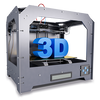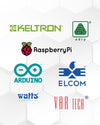
Raspberry New Silicon : Raspberry Pi Pico
It's been few weeks since the release of new silicon from Raspberry Pi. The new microcontroller RP2040 is the result of many years of hard work by the chip design team of Raspberry Pi, RP2040 has been in development since 2017. Now it's trending in the market, let's take a look into RP2040 and the low-cost breakout board for RP2040.

James Adams the COO & Hardware Lead, Pi Trading, shared in his blog the three major design goals of the RP2040 microcontroller
- High Performance, particularly for the integer work loads
- Flexible I/O (Input/Output) to communicate easily with the external device
- Low Cost to eliminate barriers to entry
The chip design team of Raspberry Pi has done an amazing job, developed a powerful little chip of size 7 x7 mm QFN-56 package containing 2 Sq.mm of 40 nm silicon.

The major features of RP2040:
- Dual-core Arm Cortex-M0+ @ 133MHz
- 264KB of on-chip RAM
- Support for up to 16MB of off-chip Flash memory via dedicated QSPI bus
- DMA controller
- Interpolator and integer divider peripherals
- 30 GPIO pins, 4 of which can be used as analogue inputs
- 2 × UARTs, 2 × SPI controllers, and 2 × I2C controllers
- 16 × PWM channels
- 1 × USB 1.1 controller and PHY, with host and device support
- 8 × Raspberry Pi Programmable I/O (PIO) state machines
- USB mass-storage boot mode with UF2 support, for drag-and-drop programming
The Raspberry Pi single-board computers handle very tough computations, network access, and storage while the microcontroller RP2040 handles analog input and low - latency I/O.
For the beginners who are using a high level language, Raspberry pi has worked with Damien George creator of MicroPython to build a polished port for RP2040. This exposes all of the chip's hardware features, including Raspberry Pi innovative PIO Subsystem. Aivar Annamaa developer of popular Thonny IDE has added RP2040 MicroPython support to the Thonny IDE widely used for python programming.
The Raspberry Pi Pico is a very low cost microcontroller development board. The name " Pico " means short and it is very smaller than a Raspberry Pi Zero known as the most compact in the Raspberry Pi single-board computers. The miniature marvel Pico has only the size of a gum. It is powerful to control anything from smart home systems to systems in industrial factories. This powerful chip supporting input voltages from 1.8-5.5V.
The Single push button " BOOTSEL " for Boot Selection can be used to enter the USB mass storage mode at the boot time and also as a general input. Pico has a single LED. Users can solder straight header pins, also use the castellated edges to solder directly to the carrier board.
The next amazing part is the documentation provided by the Raspberry Pi foundation. Alasdair Allan of the Raspberry Pi team has played a major role in preparing the detailed document covering every aspect of the design with simple and easy to understand with examples. These well prepared documents help to get the most out of your Raspberry Pi Pico
The Raspberry Pi Pico can be programmed using MicroPython or with C/C++. For the power users, Raspberry Pi Provides C SDK, a GCC- based toolchain, and Visual Studio Code integration. The drag and drop feature makes it ideal for beginners to start programming.
Stay tuned for more blogs and tutorials on Raspberry Pi Pico .



